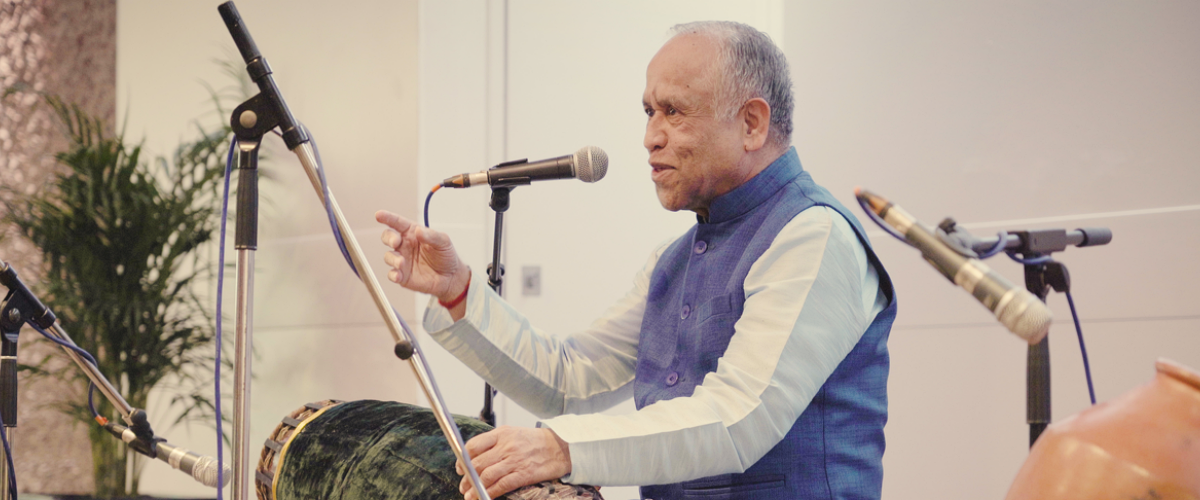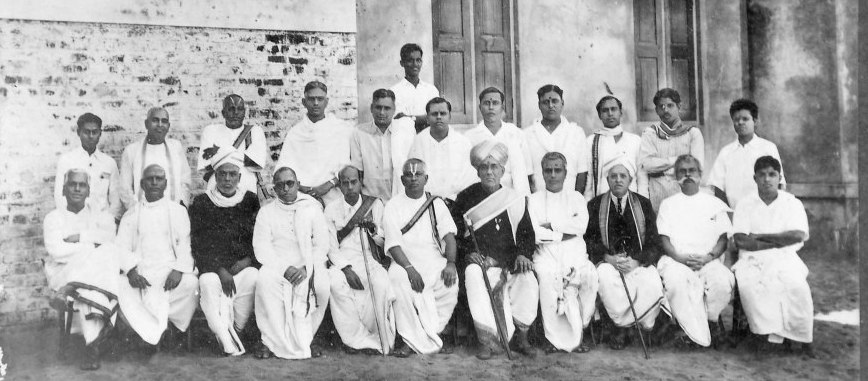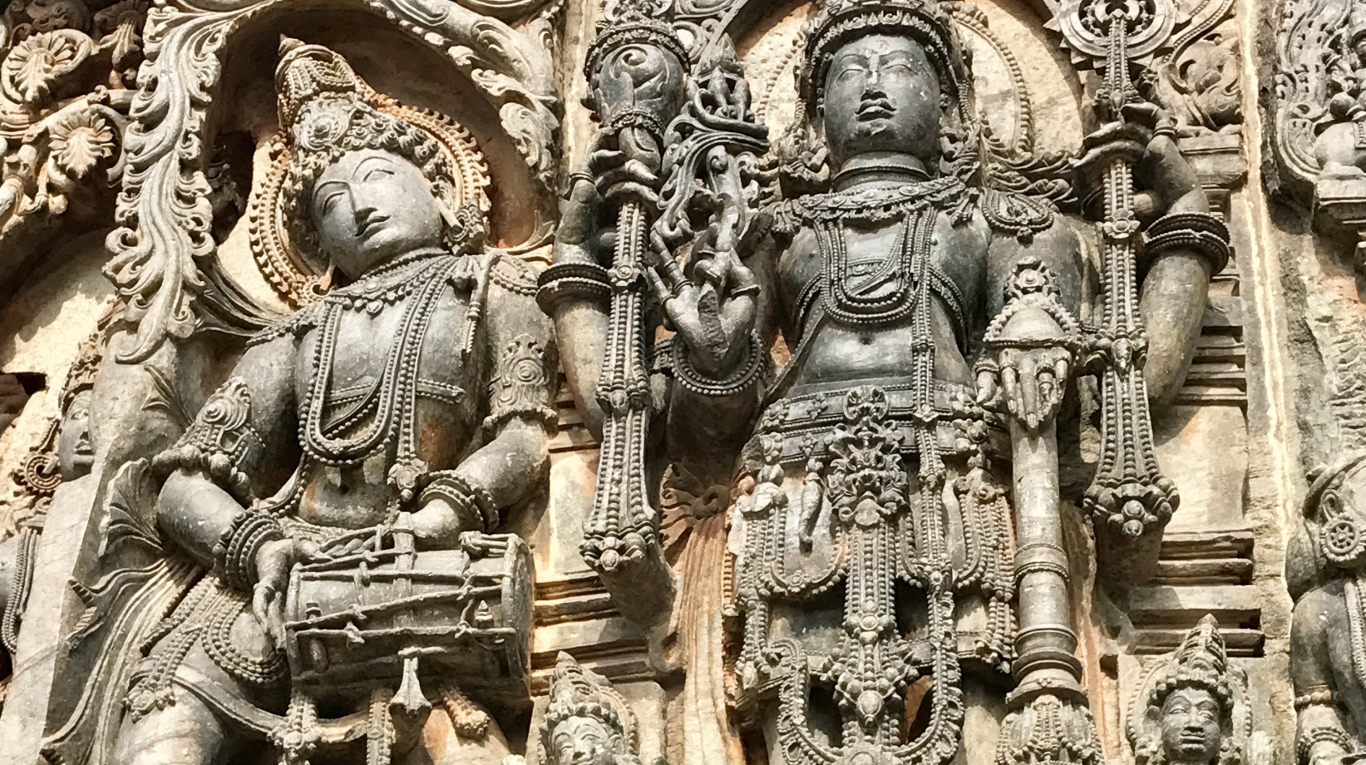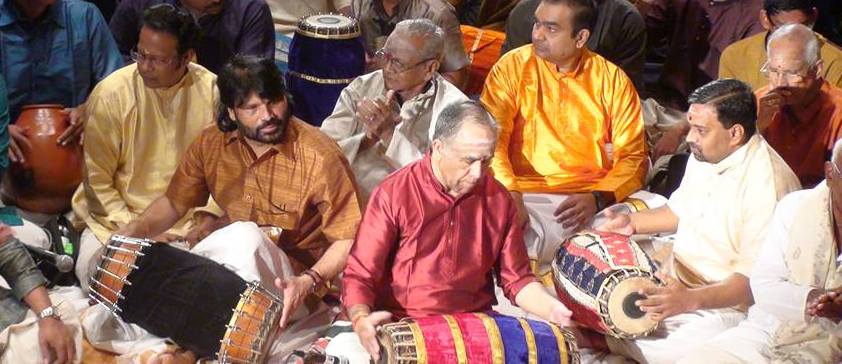

The Mridangam maestro discusses cross-cultural teaching, the rhythms of the ocean, and the future of Carnatic percussion.
—Part of Living Traditions: 21 articles for 21st-century Indian classical music
Trichy Sankaran is a global ambassador for the mridangam, a double-headed South Indian drum. Crafted from the wood of the jackfruit tree, the instrument has a rich history. It is depicted in ancient temple carvings across Karnataka, and prototypes were used to accompany early Hindu religious ceremonies. Indian epics such as the Ramayana refer to it by name, describing the mridang-like patter of stormclouds.
Some call it a deva vadyam (divine instrument), considering it to have mythic origins. Variously fabled to have been invented by Lord Ganesha, the elephant-god, or Nandi, the bull-god, it is said to have been played during Lord Shiva s tandav creation dance, sending primordial rhythms echoing throughout the heavens. It still has a central place in modern Carnatic music, anchoring the instruments around it with booming bass thuds and a distinctive high-register bounce.
Few can play it like Dr. Sankaran - a classical master and prolific fusioneer who has devoted his life to furthering its cultural and technical reach. Born in Tamil Nadu, his early musical path followed a typical sequence - childhood training within the family, rigorous instruction from an esteemed guru, and burgeoning acclaim as a young accompanist. But in 1971, at age 30, his path deviated sharply.
He left for Toronto's York University, taking up an unexpected invitation to teach Carnatic rhythm in Canada and expecting to be there for a few years at most. But he became fascinated by the challenges of the role, staying for the long term to invent new methods of rhythmic instruction. He has taken on thousands of students and collaborated widely, working with dancers, jazz groups, classical orchestras, Gamelan ensembles, and West African drummers to name a few. He returns to Chennai each year as a star accompanist in the Madras Music Season, but has never moved back to India.
The mridangam is among India's oldest instruments. Photo: Rehmat Rayatt
My pre-interview research led me to expect a somewhat reserved approach. Dr. Sankaran is a university professor as well as an elder statesman of the Carnatic tradition, and his writings displays a careful clarity. But my assumptions were misplaced - within a few minutes we laughing at how Skype audio warps the sound of obscure folk drums and swapping stories of how rhythmic playfulness permeates our everyday lives. This is a man who really loves what he does.
"I'm one of those people who constantly thinks of laya [rhythm]. I can t help but see it in the world around me - if I'm at the airport then my mind will wander, and I often take my notebook to the doctor's waiting room so that I can start writing new korvais [compositions]. I always find that trains have their own particular rhythms. It s everywhere - even the street noise can take on rhythmic qualities."
Those who grew up on the same street as the young Sankaran would empathise literally. As a child his practice regime began early in the morning, turning the tones of his mridangam into a sort of neighbourhood alarm clock. He looks back on this time with fondness: "It was wonderful. At age five I started with my cousin, who was the only musician in the family. He was 18 years older than me and kept an emotional distance, treating me as his disciple. It was hard work - I had to wake up at 4am each day - but I loved the music, and the discipline really helped me learn. I was constantly listening and absorbing".
He went on to become the star disciple of Palani Subramania Pillai, a towering figure in 20th-century mridangam history. "When I was seven I was placed in the care of my great guru. I studied for hours each day, making my debut in 1955 with him at the age of thirteen. We performed dual-mridangam duets until his death seven years later. He gave me great encouragement and introduced me to all the stalwarts of the age. I was very lucky to have such a guru."

Palani Subramania Pillai (back, 5th right) at a 1943 Madras Music Academy gathering
India's gurukul (master-student) system is distinctive for the directness of its methods as well as its intensity. Sankaran's experience was common: "We don t use writing and there isn t even much speaking. You learn by example - this is the essence of the gurukul. You sit opposite the guru with your drum, aiming to copy and understand. It s about self-discovery, so you don t ask many questions."
He clearly believes in the power of traditional teaching practice, with its emphasis on one-on-one instruction and round-the-clock immersion. Like many Indian learners he lived at the home of his guru, and these early experiences have shaped his musical and social worldview, allowing him to live out his passion full-time.
But his own teaching career has been built on very different foundations - after all, you can hardly transplant the gurukul to a Western university setting, where students are taught in groups for a few hours a week. So what attracted him to leave such a promising performance career to teach part-timers on the other side of the world?
"I went to Toronto on the specific invitation of York University, who were founding an Indian music program. I wasn't looking for a job like this - I was a performer much more than a teacher, and my masters degree was in economics. The chance to take our rhythms to new audiences was exciting. But overall I was unsure, and accepted on the condition that I would stay no more than two years."
"At first I was taken aback by the questions of the students, but I quickly developed a liking for it - very different from the gurukul! But over time I was able to design a curriculum to suit their needs, with the assistance of my co-founder Jon Higgins."
Higgins, a curious character, was instrumental in promoting Carnatic classical in the West. A uniquely talented ethnomusicologist and performer, he dedicated decades to learning the intricacies of South Indian vocal music, becoming one of the first Westerners to receive acclaim for performing classical Indian music to its home audiences. Early reviews in The Hindu newspaper express wonder at how a Connecticut Yankee could sing with such remarkable empathy for the grammar and idiom of Carnatic song (listen here), and he eventually became known as Higgins Bhagavatar (scholarly master).
It was Higgins who first invited Sankaran to Toronto, almost a decade after meeting him for percussion lessons in Madras. They worked together to establish York's Indian music program, approaching from different angles: Higgins was an American teacher who had gradually turned towards Carnatic performance, Sankaran an Indian performer who found himself teaching in the West. How did they go about collaborating?
"Jon asked me to lecture rather than just demonstrate. I said ‘are you kidding - we don't talk about our playing very much! He insisted, so I thought about it, and prepared something on two days notice. It was all on the blackboard, but I took the drum for security, in case I got lost and had to play it! But I didn't in the end. The experience was interesting, and there was no looking back."
"We had to develop analytical approaches to suit the university environment. I would demonstrate a korvai and explain how it worked - the strokes, the structure, the rhythm cycle. Phrasing is always vital - the punch marks, the accents, they all have to be in the proper places. This is the main reason some drummers are more attractive than others. But I had never had to explain it in these ways before."

12th-century carving of Vishnu with a drummer at Hoysaleswara Temple in Karnataka
He preferred to take more time than to dilute the complexities: "I don t compromise too much. Sometimes I choose simpler korvais to put students at ease, but we must have high expectations of those who really wish to learn. Experiencing the music firsthand was crucial: I brought students to Carnatic concerts in Toronto, translating the lyrics of kritis [three-verse songs] and making them available to the audience."
Carnatic rhythm uses solkattu, a system of onomatopoetic sounds (it literally translates to ‘bunch of syllables ). The musician claps along with the underlying rhythm cycle while ‘speaking the drum strokes. It is versatile, beautifully concise, and doesn't require an instrument - practitioners can learn and dissect rhythms wherever they happen to be at the time. (Watch Dr. Sankaran demonstrate it here).
"I introduced solkattu as part of rhythm pedagogy at York. Learning mridangam is a physical process that takes years, but solkattu is a very direct medium. They can learn quickly and apply it to their own beats - folk, rock, classical, or whatever else. This was my goal of introducing it, and the results have been interesting. For example how it relates to hip-hop or scat singing in jazz. People have taken up this study very seriously these days."
I wholeheartedly concur, having learnt basic solkattu several years ago to improve my jazz phrasing. I remember first being surprised by its conceptual simplicity, then taken aback by the near-immediate results. It rarely felt like a theoretical tool, quickly becoming imbued with emotional expression and a sense of addictive fun. I even used it help keep my mind alive through the grey mundanities of life as an office worker, silently grooving off the ticking clock as dull meetings dragged on. I cannot recommend it enough - it becomes the lens through which you see the rest of rhythm.
I ask what one piece of advice he would give to an aspiring percussionist such as myself, beyond the universal basics (‘work hard, play hard'). His answer was immediate and specific: "Be really strong in one thing first. Students should specialise in their own tradition for a long time before branching out. They will find more power and understanding this way."
Learning should never be unidirectional. Explaining how music works is an exercise in nurturing your own appreciation as well as empathising with another's, and the process can often impart valuable knowledge to the teacher too. Sankaran and I discuss how some of our most fulfilling musical moments have sprung from teaching.
"The impact on my own playing has been indirect but invaluable. In particular having to think analytically - how moras [cadential phrases] are like a 3D lattice structure, or how korvai sequences increase in a pattern as you go on. The process of having to break them down led me to discover a number of new composition formulas, which will soon be published."
He has continually pushed to expand his own rhythmic horizons, working in depth with an extraordinarily broad array of global musicians (people say I wear many hats). His first non-Carnatic collaboration dropped him deep into avant-garde territory, as he found himself in a room with a mridangam, a Moog synthesiser, and a Tai Chi dancer hooked up to electrodes. The electrodes generated synthesiser patterns based on the dancer's alpha brain wave levels, and Sankaran was tasked with picking out any underlying rhythms on his drums (he named the results, sadly unreleased, Alpha Tai Chi Tala).
These left-field early experiences framed the work of later collaborators in a different light. After all, Pauline Oliveros' tape music experimentation and Anthony Braxton's acrobatic saxophone freakouts probably don t seem so far out if you re used to jamming with neuroscientists and lab equipment.
He readily embraced opportunities to fuse Indian sonorities with new textures. "Early on I worked with a gamelan [Indonesian tuned percussion] group, and afterwards decided to tune a circle of mridangam to a gamelan scale, calling it mridanga tarang ['wave of mridangam']. It's fascinating to hear the instrument you know so well in such a new context."
Collaboration is often a humbling affair - even seasoned virtuosi have to readdress their fundamentals when learning music from other cultures. Sankaran quickly discovered this. "I wanted to compose for Swara Laya, my new group at the time, but had to take a course in basic musicianship at the university in order to understand how to write using notation."

When one mridangam just isn't enough...
Sankaran aims to keep his classical playing ‘pure', but borrows carefully on occasion: "I want to be true to the tradition when I play Carnatic music, but have been influenced by certain rhythms from around the world. If I'm in triple time I may play the 12-beat gankogui pattern, which I learned from West African drummers. But such elements must be used tastefully."
He has run the gamut of global percussion styles, teaming up with artists from five continents. But jazz has always held a certain magnetism. He has worked with figures including Dave Brubeck, Charlie Haden, and Vijay Iyer, and describes the music as being "close to my heart".
Indo-jazz similarities are readily apparent and much-explored - extended solo improvisation, intricate rhythmic subdivision, expansive scale systems, an emphasis on maintaining flow, and so on. The ‘head' melody of a jazz standard functions much the Carnatic pallavi (thematic song line), and Sankaran has written pieces that fuse Western scales with their South Indian cousins (Jazzadorian in Raga Kharaharapriya). But I was more interested in where he feels the styles differences are.
"Most clearly we can say that Carnatic music tends to lack chord progressions, and that jazz doesn t use such a wide range of melodic ornamentations as we do. And I also remember one of my jazz-playing students asking me ‘How do you think ahead? How do you make sure your phrases tie up? . It s difficult to explain, but Indian music almost always hits the downbeat, whereas jazz has more flexibility with using offbeats. So you re thinking ahead to different places. In Indian music you have to know exactly where you are."
"The three-feel of jazz swing isn't found so much in Carnatic rhythms, but our approaches are versatile and so there are ways of handling it with solkattu. My guru was one of the first to use swing ideas in Carnatic tisra [triple time], and also introduced fives in a most subtle way. In 1959 he played on All India Radio with Joe Morello, Dave Brubeck s drummer - some say the inspiration for Take Five came from these sessions."
Indian classical music is famed for its intricate detail and intimidating technical demands. But Sankaran also knows that its collaborative power is just as dependent on openness and flexibility. "We are very proud of our traditions - Carnatic is so fast, with so many patterns. There are endless possibilities, and we sometimes say we are the king of rhythm cultures. But learning to appreciate other music strengthens everyone, and provides more ideas for the musician. We can bring out more of our personality this way."
.jpg)
Crowds celebrate the life of saint-composer Tyagaraja in Tamil Nadu. Photo: B Balaji
Dr. Sankaran has been a leading classical performer for decades, and has now accompanied musicians spanning five generations. Our interview took place during a break in his schedule for the Madras Music Season, which sees Chennai pack several thousand Carnatic concerts into a fortnight. He returns to play at the festival each year, and sees subtle changes each time. I ask him how he feels about these new directions.
"I've noticed that modern performers are into quite cerebral types of creation - more abstract and mathematical. I appreciate how they have furthered the art, with new rhythms, new korvai formulas, and so on. But the aesthetics can suffer on account of this. The ability to appreciate slow music is disappearing too, and some of the slowest talas are near-obsolete now."
He laments that you don t see full bench percussion sections as often nowadays - mridangam, ghatam (clay pot), kanjira (tambourine), morsing (jaw harp), and konnakol (vocalisations). "We used to have a konnakol performer as part of the traditional ensemble, but today few take it to that level. This was another reason for wanting to preserve it in my teaching."
"Western influence is coming in more and more too. Overall this is a positive thing - our music is modal and melodic in nature, but we are now seeing what harmony can bring. There s a new concept called melharmony which I have used. And we should remember that filmi music already combines classical ideas with chords."
He left Tamil Nadu half a century ago, and returns to a very different music scene to the one he left. I ask him what Carnatic music might look like in another 50 years. "Of course this is hard to predict. But I think that fusion trends will continue. Shakti [John McLaughlin s pioneering late-70s group] were the eye-openers in the beginning, and such things are bound to happen more and more with our globetrotting musicians. But today they often miss the possibilities that are there. It s about the ideas as well as the sounds - just having a mridangam alongside a drumset doesn't turn something into fusion."
"And with new technology comes new mridangam designs, which expands the range of sound. Some use screws to tune now. And though microphones are very important, they have led us to forget some of the properties of acoustics. Some musicians can adapt, but others have had problems. They are not made or adjusted properly for mridangam either - in fact I think that the old omnidirectional mics gave a better sound than the pairs people use today."
Teaching methods are in constant flux too. You can now search out and study the music of disparate cultures online, and Indian classical has a growing community of distance learners. Sankaran has aimed to keep pace without unduly compromising the old ways.
"I have students on Skype, but am very selective. And I insist that they meet with me every 6 to 12 months wherever possible, so I can correct their hand positions. Also there is a bit of a time lag over the internet, so it s hard for a student to play with you! But it s possible to learn to a high level provided the student stays in touch and strives for perfection."
"Learning to appreciate other music strengthens everyone". Photo: Rehmat Rayatt
Now 76, Dr. Sankaran can look back on a lifetime in Carnatic rhythm. He has taught thousands of students, written weighty theoretical books, and performed with some of the music world's leading lights. But he continues to travel the globe, bringing the mridangam to new ears. What continues to drive him?
"Laya is a part of life and must reflect its ups and downs, tensions and releases, and so on. It s not always smooth, not always happy. Like life, rhythms are ambiguous - I've analysed thousands of compositions and have come to feel that for each rhythm there is a counter-rhythm. And the perception of each person is different. Great masters have experienced laya in various ways."
His conversation is consistently interspersed with references to music s divine nature. "There is always a spiritual dimension to the laya. The pranas [life elements] of rhythm have to be found. I often quote a Sanskrit sloka: ‘Chanting ten million times takes you to the meditative level, then you realise the laya . You must develop this deeper sense. I use rhythms to meditate, to really clear the mind."
He believes rhythm brings other benefits too. "I've heard that drummers rarely get Alzheimer's. Maybe it has to do with the constant ticking - it keeps you alive!". The science seems to back him up, with research studies finding that music therapy can delay the onset of the disease, and allow those with it to become "alert, happier, [with] higher recall of past personal history". Perhaps more of us should try Dr. Sankaran's prescription.
Now 76, he is a revered member of the Carnatic establishment. His long musical path has led him to embody many different roles - traditionalist, fusioneer, teacher, performer, scholar, philosopher, and plenty else. But in conversation he has all the immediate energy of a wide-eyed child, as if sitting in the kitchen discovering the power of banging pots and pans in sequence. In his words, "music is an intuitive joy, and for it to bear fruit you cannot answer every question. It is always a mystery in the end."
Put this way, it is not hard to see why he continues to strive. After all, us percussionists know that questions about why they do it should be flipped round. Why wouldn't you want to keep touch with such immediacy and playfulness? Why would you ever stop when you draw such a basic joy from continuing to learn?
I ask him where he finds musical satisfaction. "I particularly love to be at the shoreline looking at the waves roll in. I still recall the korvais my guru taught me at Madras Beach half a century ago, and have written many ‘beach korvai of my own since then. The flow is very useful for understanding and creating - it helps your mind so much. They say every seventh wave is stronger - does that mean the ocean moves in a seven-beat cycle?"
• George Howlett is a London-based musician and writer, specialising in jazz, rhythm, Indian classical, and global improvised music.

"I still recall the korvais my guru taught me at Madras Beach half a century ago..."
Darbar believes in the power of Indian classical music to stir, thrill, and inspire. Explore our YouTube channel, or subscribe to the Darbar Concert Hall to watch extended festival performances, talk and documentaries in pristine HD and UHD quality.
The ghatam is a South Indian drum resembling a porous earthenware or clay pot, a common household object in North and...
Read More 
Welcome to Living Traditions - a new written collection by Darbar's George Howlett, exploring how music with ancient...
Read More 
The mother of all North Indian drums, the pakhawaj is also known as the mridang, the generic word for any...
Read More 
The beginner's guide to Indian classical music. Whether you’re completely new to raga music or just need a refresher, we’ve put together this brief overview of all things raga music to help you feel at ease when visiting one of our concerts or watch our videos on our YouTube or our Darbar Concert Hall.
Keep up to date with the latest news, events, music and musings across our social channels
For hundreds more clips and shorts, vist our YT page here 